Amazon is the largest online trading platform in the world and one of the most popular Internet sites. Through it works 3 million sellers, 350 million different goods are placed here. Amazon is responsible for 4 million deliveries per day. To cope with such a flow of applications, the company - mostly in warehouses - employs 270 thousand employees. This is four times more than the entire Google.
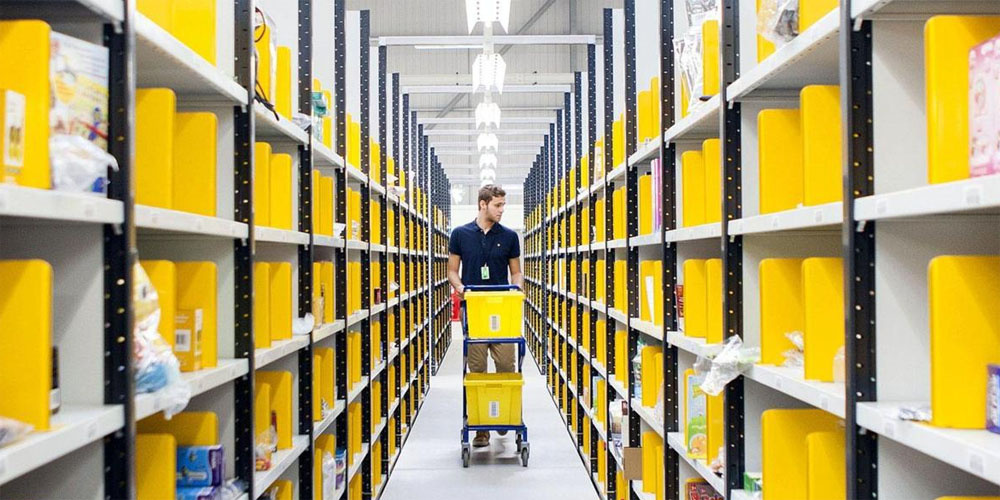
So that no worker spends time in vain, the company has developed a huge control system, subject to strict algorithms. At the head of everything are computer systems that count on what each person should do. Amazon was fined several times for being too hard on its employees, this is a job for wear (or for those who want to lose weight very sharply). The company does not like to share its secrets and disclose the algorithms by which all of its 90 giant warehouses, “Executive Centers”, function. But we in
Pochtoy take hundreds of orders from them every day, and yet we found out something interesting about them.
Supermarket Warehouse
Each Amazon executive center covers 50-60 thousand square meters. This is about eight football fields. Everywhere yellow and orange colors, branded from the company. The space is well lit, but there are almost no sounds around, despite the presence of more than two thousand people. Only the rumble of conveyor belts and the rumble of the steps of employees walking behind the next goods are heard. They silently collect orders, silently stick the boxes. Everyone is focused on their business, there is no talk here. The system monitors the effectiveness of a person, and if he does not fit into the standard, he is immediately fined or fired. Therefore, no one can afford to spend an extra second.
New employees should not learn departments with the goods. They are simply not here. Each product is put where there is a place. The endless rows of shelves resemble a supermarket or library. Only all in complete "chaos", without sections. The book may lie near the plane, the iPhone - near the jeans. A person does not understand this logic.
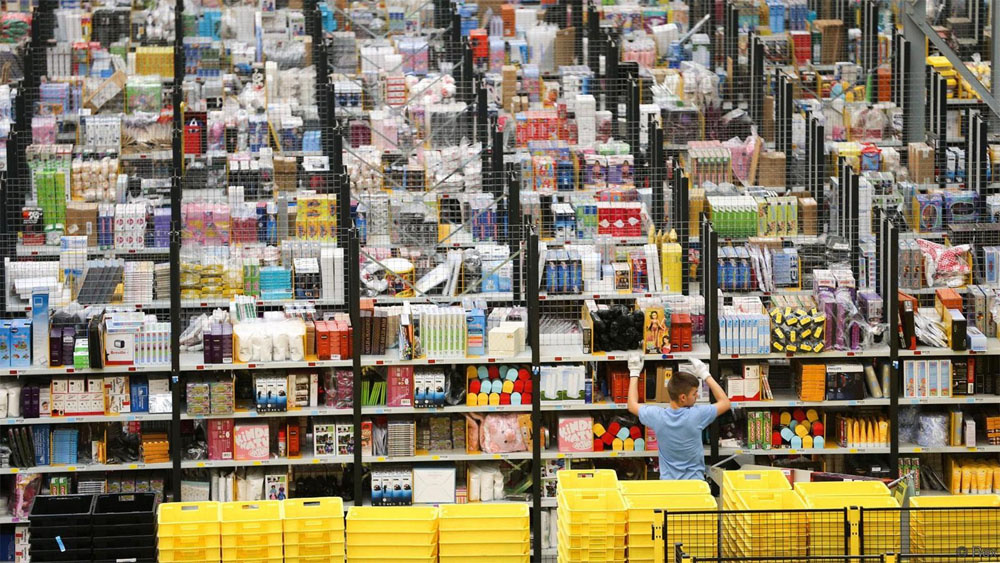
The system works by barcodes that are stored in the warehouse database. Each new product receives its code and is sent to the cell that is free and located as close to it as possible. And when an order arrives at the site and the goods must be picked up, the nearest free worker on the display of his scanner “pistol” shows the number of the row and shelf. When the employee arrives at the site, it remains to once again read the bar code to confirm that there was no error. And immediately on the scanner immediately the next target lights up - with the address of the cell and the expected time for which you need to have time to take the goods. Sometimes this “target time” is 5-10 seconds. And your boss will see if you do not have time.
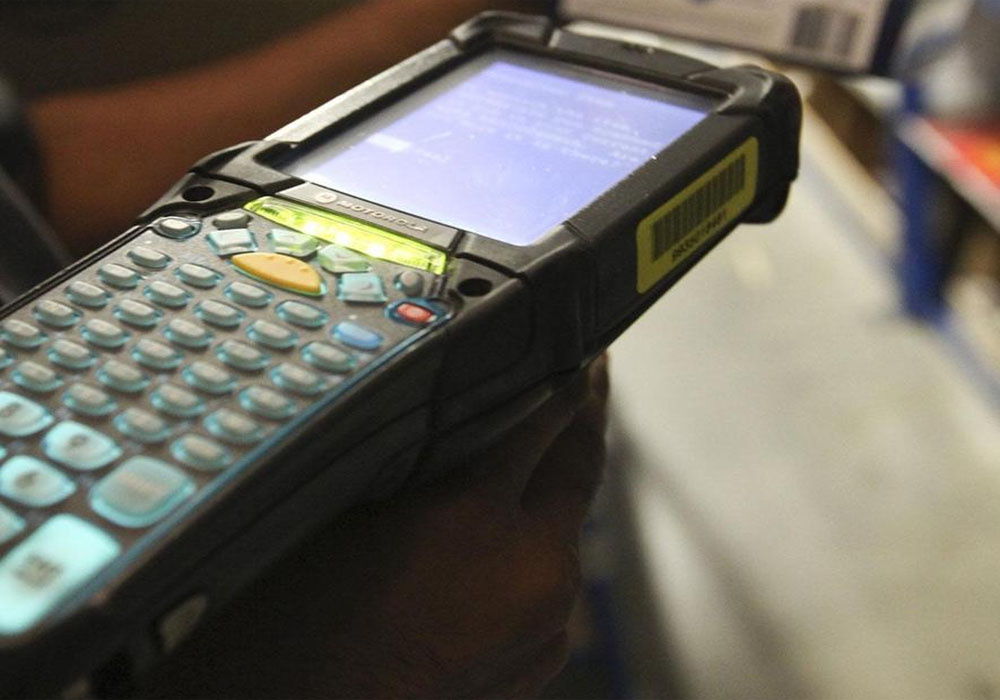
The turnover is large, and there is zero confidence in the employees. At the entrance to the warehouse, you must leave everything, including the phone, in your locker. You are given a reflective uniform without pockets and a handheld scanner “gun”. In addition to him, you can only carry a bottle of water and a transparent bag for money - to buy food in the dining room. In a separate room in front of the monitors sits the security team, tracking the movements of all employees through their scanner. Such a system would probably be used by security in a high-tech prison. If a person moves away somewhere or stays in one place for a long time, a manager is sent to him to assess the situation. And at the exit - another check, as at the airport, to exclude cases of theft.
Comfortable environment? No, this is not Google. Amazon is not among the top US employers either. But the system gives the result. Conveyor belts are moving so fast that, for example, the "Executive Center" in Kentucky can process 400 orders in one second. A parcel truck leaves the warehouse every two minutes. No one else has such an effective system in the world. The human factor is almost completely eliminated, everything is controlled by algorithms.
What happens to the product: the path from the order on the website to home delivery
Manufacturers send their products to Amazon, and the company distributes them across its network of warehouses. This takes into account the previous order history, and if some region, say, especially likes to buy sneakers, it increases the likelihood that a new batch of shoes will be sent there.
The process of receiving goods is almost as important as sending it. Workers open the boxes in the trucks, take things out of them, put a marker on them and shift them into baskets for transportation. Conveyor lines deliver these baskets to different parts of the warehouse, where other workers unload them, put them on the shelf, scan the product itself and scan the bar code of the cell in which it will be stored. From now on, the Amazon system will know where the item is sitting. Nobody has more such information. For a person, there is complete chaos and confusion.
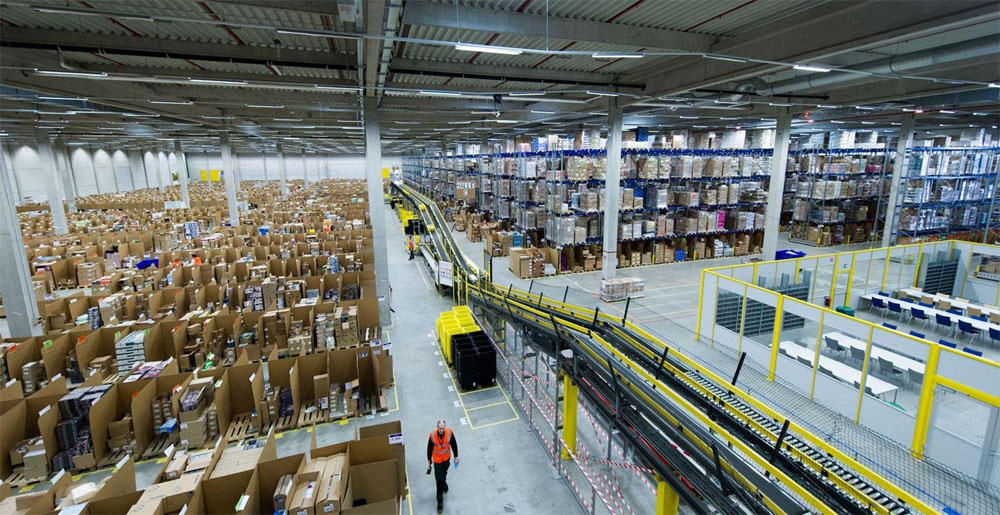
The shelves are divided into small sections, and things are stored in them, like books in a library. Each cell has a bar code and an alphanumeric code (for example, P-1 A526 770 8: section, row, number in row, cell sequence from the floor). The cell code does not say anything about its contents. Goods are evenly distributed throughout the warehouse so that employees do not have to go long. There is only one rule: two identical products cannot sit in the neighboring cells in order to minimize the human factor here as well.
When you order something on the site, the Amazon system quickly understands where such goods are located in the warehouse closest to you and identifies an employee who is currently passing close to this cell. He has information on the scanner where to go. A whole army of such “collectors” works in the warehouse, moving in complete silence from object to object. During the day, each of them must find, scan and take to the conveyor at least one thousand goods.
The conveyor cargo arrives at one of the filling stations. Workers arrange goods on high shelves on wheels. This is where different products from the same order come together. Each slot on the shelf - a separate order. Then the shelves roll into place of packing, and the contents of the slots are “rammed” into cardboard boxes of suitable size, known to anyone who has ever ordered something from Amazon.

At this stage, the algorithms again force people to work at their peak. On the computer screen shows the optimal box size for each order - and the time during which it must be packaged. From the side, bags with air roll out, playing the role of pillows and softening the delivery, and tape, which the whole thing should be glued together. It usually takes thirty seconds to assemble one order. Hundreds of people work with the speed that we usually see only among the Chinese in the promoted youtube video.
The difference with the Chinese is that workers in factories in China are given bonuses for overfulfilling the plan, and employees of the Amazon warehouse are only fined for delays. Because of such a tough approach, which journalists in the United States called "a paradise for the client, hell for the employee," the turnover of personnel at the company is very large. On average, it is kept for 12 months. In this case, Amazon has the second (from the end) result in the Fortune 500 list. And this is despite the fact that they pay 30% more than the industry average.
Just for interest: at Microsoft, the statistics officers have been holding for 4 years, at Xerox - 7.2 years. Do eBay and Yahoo! - only 2 years. And the worst of the well-known companies are things at Google. On average, the search engine leaves after 14 months. But these are highly paid professionals who went on increasing or entering a startup. Other people with a different perspective and a different level of remuneration leave Amazon slightly.
Packed boxes are shipped via another conveyor to the machine, marking and mailing labels. Then, stamped, orders go down to a large concrete basement, wait for loading. From here they are shipped by FedEx, UPS, other postal / logistics companies, and Amazon itself.
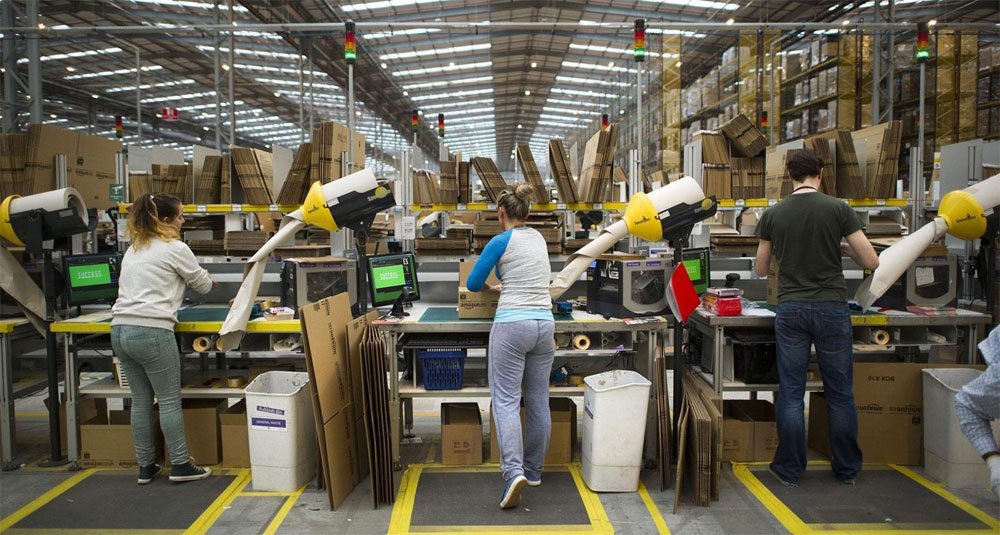 Packing parcels at the exit
Packing parcels at the exitSo far, the retailer has not yet come up with the optimal algorithms for “dumping” the packages into the truck - and maybe it loses a couple of percent, if not all of the movers in childhood loved Tetris. But the company compensates for this with a powerful separate system that analyzes the best route and delivery method for each individual product. Saving gasoline for the year results in millions of dollars, and the package comes to the buyer a few hours, or even a few days earlier. The company claims that on its three busiest days in 2016, Black Friday, Cyber Monday and the first Monday of December, it delivered 99.9% of orders within the deadlines stated on the website.
Shipping is free for many products in the USA. In Russia - you have to pay, and often quite serious money. Amazon itself does not do this (in fact, some of the goods are delivered, but for fabulous money), so the parcel usually goes through one of the intermediaries. Payment depends on the weight of the goods. The cheapest option is
FastBox from $ 8.99 per 500 grams .
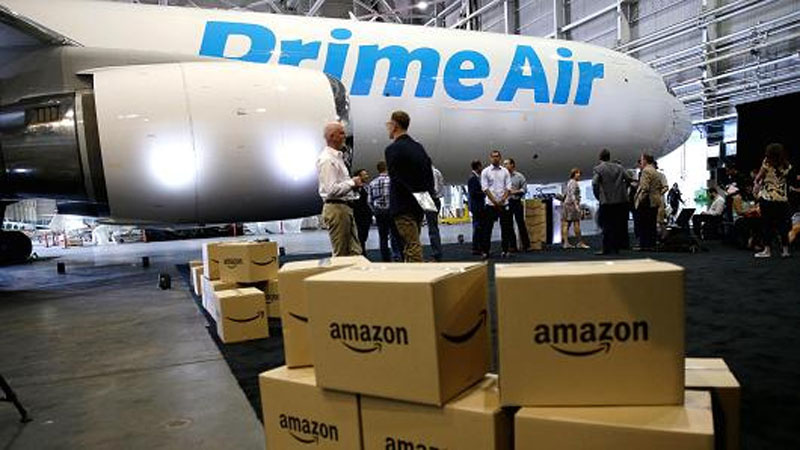
In order to further speed up the delivery and lower commissions for themselves, by removing the monopolists from the market, in April 2017, the company launched the delivery by aircraft. Across America, giant planes with Prime Air's livery are already running. Amazon is going to spend $ 1.5 billion on its fleet, including Boeing 767 and drones.
Robots replace people
In 2009, Jeff Bezos, founder and head of Amazon, wrote a letter to the shareholders of the company, declaring the war "Muda". This is a Japanese term meaning "uselessness", "loss" or "waste", which Toyota first used. For Amazon, this meant that everything that was possible should work as efficiently as possible. Company statistics, for example, shows that accelerating page loading by 1/10 of a second leads to an increase in consumer activity by 1%. For Amazon, these are billions of "bonus" dollars. Delivery delays are also unacceptable, even if it is a couple of hours. The company on this occasion can be said fad.
The use of drones for delivery in cities is not yet allowed, and there is a speed limit for cars on the roads. Therefore, almost the only way to significantly speed up delivery is to continue to optimize the work of the “collectors” in the warehouse.
And there is something to optimize, even though they and their scanner-guns find the product in seconds. The main problem that Amazon has identified for itself is the human factor. First, according to the requirements, workers should be able to lift up to 22 kg and spend 10-12 hours on their feet. During the shift, they are 12-20 kilometers between the shelves. Errors in this mode are almost guaranteed. And if someone cannot lift a load, or if a person suddenly confuses a row / shelf / cell number - this is another slowdown.
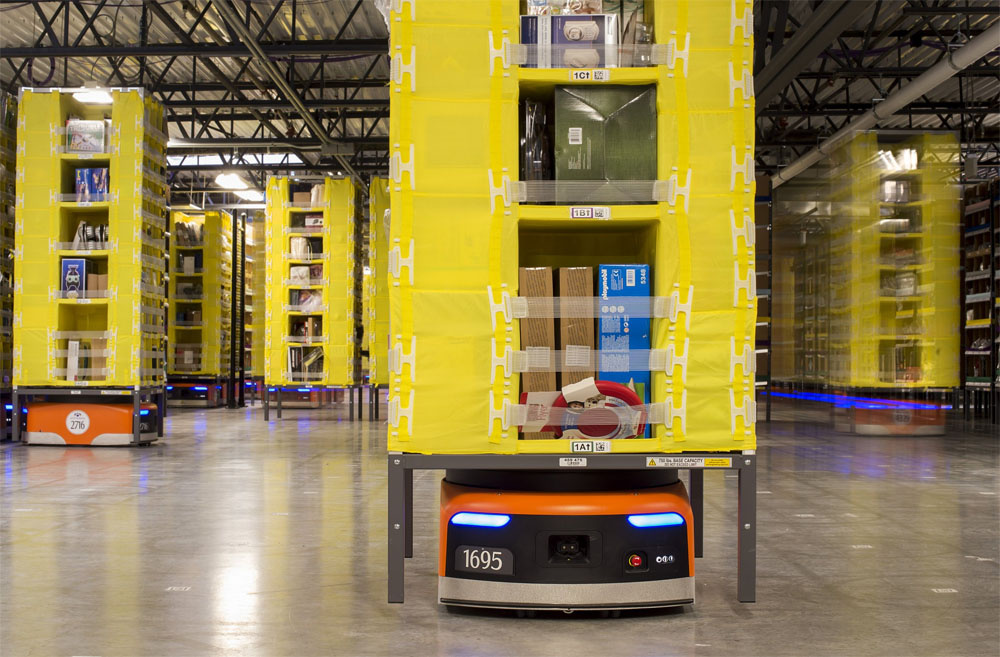
Therefore, the warehouses of Amazon are actively robotized. In 2012, the company bought a manufacturer of robots, Kiva Systems, for $ 775 million. Now, about 40,000 of their machines, similar to large orange glasses, are working in the store's warehouses. Ideally, such robots themselves will choose the right product and deliver it to the truck, but for now their task is simpler. A mobile shelf is placed on top of the robot. And when the goods in one of the cells becomes necessary to the buyer, the robot itself delivers the shelf to the person. It turns out much more efficiently: people do not have to run, they make fewer mistakes. The robot does not get tired, it can work indefinitely and move any weight. A bunch of power automatics and the human brain so far is the most productive. But Amazon Robotics technology continues to improve, and maybe in the near future, two hundred thousand American “collectors” and “packers” will have to look for a new job. And Amazon's automatic drones, delivering goods to their homes, are called to replace truck drivers soon. Man is the only unnecessary link in the ideally tuned machine of the Internet giant.
Developed infrastructure and a huge scale allow "Amazon" to keep the minimum prices. In some categories of goods, the retailer works at a loss, just to keep up with competitors. Prices on the site are usually one and a half to two times lower than Russian (no joke). And you can deliver purchases from there to Russia using Pochtoy.com. If you
register and enter the promotional code GEEKTIMES, for the first parcel from the US, we will give $ 7 to your account.
By the way, you can
read about the secrets of the Amazon IT structure in our blog
here .